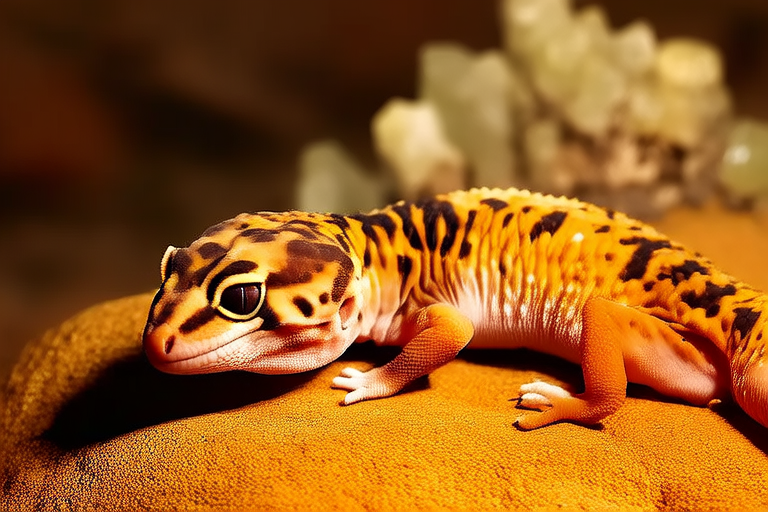Leopard Gecko Care Made Easy: A Beginner’s Guide
Welcome to the wonderful world of leopard geckos! These charming little creatures are increasingly popular among reptile enthusiasts due to their docile nature and relatively low maintenance requirements. This guide will walk you through everything you need to know to provide your new pet with a healthy, happy life.
Habitat Setup: Tank Size, Substrate, Temperature, and Humidity Requirements
The first step in leopard gecko care is setting up their enclosure properly. The ideal tank size for a single adult leopard gecko is around 20 gallons, offering enough space for movement and exploration. If you’re planning to house multiple geckos, increase the tank size accordingly to at least 40 gallons for two adults.
Choosing the right substrate is crucial. Avoid loose substrates like sand or wood shavings as they can pose choking hazards. Instead, opt for safer alternatives such as paper towels, reptile carpet, or reptile-safe bedding like coconut fiber or tile. These options are easy to clean and maintain.
Temperature regulation is vital for your gecko’s well-being. Leopard geckos thrive in a temperature gradient ranging from 78°F to 90°F (25°C to 32°C). Provide a heat source on one side of the tank, creating a warm basking area while allowing cooler areas for thermoregulation. Use a digital thermometer to monitor these temperatures accurately. Ensure that the temperature does not exceed 95°F (35°C) to prevent overheating.
Maintaining appropriate humidity levels is also important. Leopard geckos prefer a dry environment with humidity levels between 30% and 40%. Overly humid conditions can lead to respiratory issues and skin infections. Use a hygrometer to measure humidity and adjust ventilation as needed.
Diet and Feeding Habits
Leopard geckos are insectivores, meaning their diet primarily consists of insects. Feed them a variety of gut-loaded insects, which are insects that have been fed nutritious food before being offered to your gecko. Common feeder insects include crickets, dubia roaches, mealworms, and waxworms. It’s best to offer a mix of these to ensure a balanced diet.
Feeding frequency depends on your gecko’s age. Juveniles require more frequent feedings, usually every day or every other day, while adults can be fed every 2-3 days. Offer as many insects as your gecko can consume within a 10-15 minute period. Remove any uneaten insects after this time to prevent potential injury or stress to your gecko.
Vitamin and mineral supplementation is necessary to promote healthy growth and development. Dust the feeder insects with a calcium supplement without vitamin D3 twice weekly, and once weekly with a multivitamin containing vitamin D3. Always follow the manufacturer’s instructions for proper dosing.
Health Care Basics
Regular veterinary check-ups are essential for maintaining your gecko’s health. Choose a veterinarian experienced with reptiles to perform routine examinations, including weight checks, fecal tests, and parasite screenings. Keep an eye out for signs of illness, such as lethargy, loss of appetite, difficulty breathing, or unusual discharge from the eyes, nose, or mouth. Early intervention is key to successful treatment.
Proper hygiene practices are equally important. Clean the enclosure thoroughly at least once a week, removing waste and replacing soiled substrate. Disinfect surfaces using a reptile-safe cleaner, rinse thoroughly, and allow the enclosure to dry completely before reintroducing your gecko.
Handling Tips
Handling your leopard gecko should be done gently and with care. Start by allowing your gecko to become accustomed to your presence before attempting to handle it. Approach slowly and calmly, avoiding sudden movements that might startle your pet.
When picking up your gecko, support its body fully by placing one hand under its belly and the other supporting its rear end. Never grab your gecko by its tail, as they can drop their tails in defense if threatened. While this process is not harmful, it can cause stress and may leave your gecko vulnerable to predators until a new tail grows back.
Limit handling sessions to about 10-15 minutes per day to prevent undue stress. Each gecko has its own personality; some may enjoy being handled more than others. Pay attention to your gecko’s behavior and respect its comfort level.
Common Mistakes to Avoid
One common mistake is providing insufficient hiding spots. Leopard geckos are naturally shy creatures and require dark, secure places to feel safe. Incorporate multiple hide boxes throughout the enclosure, ensuring there are both warm and cool options available.
Another frequent error is neglecting the importance of calcium supplementation. Insufficient calcium intake can lead to metabolic bone disease, causing weak bones and deformities. Always follow a consistent supplementation schedule to prevent deficiencies.
Lastly, overfeeding is a concern. Excess fat can lead to obesity and related health issues. Monitor your gecko’s body condition and adjust feeding amounts accordingly. A healthy gecko should have a slight taper from shoulders to hips without excessive bulges.
In conclusion, leopard geckos make fantastic pets for those willing to invest time and effort into understanding their needs. By following the guidelines outlined in this beginner’s guide, you’ll be well on your way to providing your gecko with a comfortable home and a long, healthy life. Enjoy your journey with these delightful reptiles!
